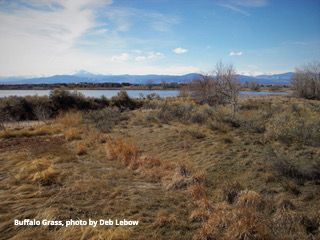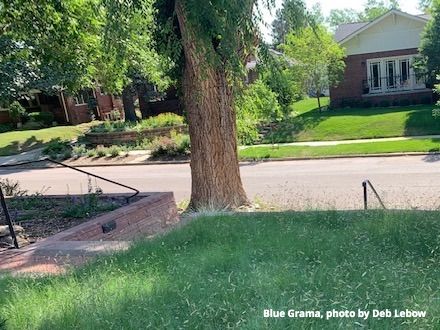By Deb Lebow Aal
There are a myriad of reasons to get rid of turf grass such as the ubiquitous Kentucky Blue Grass lawn on the Front Range, not the least of which is the amount of water it takes to keep it looking green. Why we have as much turf grass (I’ll use the term turf grass or lawn to mean Kentucky Blue grass and other non-native grasses we use as lawn) as we do on the Front Range is a mystery to me, but history gives us a hint.
Turf Grass Lawns: Past and Present
Before the civil war, lawns were unusual in the U.S. They were impractical and difficult to maintain. Very few Americans had traveled to Europe, so although lawns began to appear in England and in France in the 18th century, they were not a style in the U.S. till much later. Thomas Jefferson saw those expanses of green lawns in Europe, and, greatly impressed, tried to copy the style at Monticello. George Washington also tried to achieve this European style at Mount Vernon, and thus, the idea of a lawn started to take hold, here. Jefferson and Washington gave wealthy Americans something to emulate, and lawns became a symbol of wealth and power.1 A lawn was not easy to grow before the advent of pesticides, herbicides, chemical fertilizers, and the lawnmower. You needed manual labor (which was slave labor at that time), and land that did not have to be productive. Most people could not afford either of these luxuries. But the idea of the lawn became popular and, eventually became the default landscape in America. It is still a show of wealth, whether we know it or like it, or not.
Now, I get that an expanse of green is soothing to the eye, frames a flower garden well, and can be beautiful. It just does not belong here, if it is Kentucky Blue Grass and the like, on the Front Range. And, by the way, Kentucky Blue Grass is not native to Kentucky, or any part of North America.
But, you say, my lawn is easy and other alternatives are not!
That is true and not true. Certainly you don’t have to think about turf grass very much. You know you have to water it and mow it and weed it and fertilize it, but it requires no creative thinking, and you can hire a mow and blow company to do all that. But, you are putting a lot of effort, or someone else’s effort and your money, into something that supports little to no wildlife. No birds, butterflies, or other pollinators dine on your lawn. It is pretty darn sterile. Well actually, Japanese beetle larvae develop primarily on grass roots, and geese seem to like grass as well.
As of 2005, there are 63,000 square miles of turf grass in the U.S. (about the size of Texas). It’s our biggest crop by far and it feeds virtually no one. It is truly time to think differently, and save a little (or in some cases a lot) of time and money, not to mention the ecosystem.
As I have mentioned many times before, 55 percent of residential water in Denver goes to water our outdoor landscape. And most of that is to keep this utterly sterile lawn green. I have seen a statistic that 60 percent of our outdoor landscape in Denver is lawn. As I look around my Denver neighborhood, it looks more like 85 percent. It is a lost opportunity to save water, or use the water for something that supports pollinators, birds, and yes, humans. As Dr. Douglas Tallamy says, “You can’t run a supermarket on just bread, and you can’t run an ecosystem on just lawn.”2 We can and should do better than that.
To be clear, even though you may want your landscape to be easy to maintain, there is no such thing as a maintenance-free yard. Not if you want it to look nice. You will always have to pay attention, or pay someone else to pay attention, to your outside space. I wish this was not something we had to write about; that people wanted to be outside, sticking their hands in the dirt, spending some free time in their yard, but that is not the case. There are many who do not want to pay attention to their outdoor spaces. If this is you, this article is probably not for you, unless we convince you that a garden is a worthy creative endeavor. It can actually help your mind, and your body…but I digress.
Turf Grass Alternatives
Better alternatives for the Front Range, where water is scarce, and not as expensive as it should be (yes, I said NOT as expensive as it should be. My opinion, of course):
Buffalo Grass (Buchloe dactyloides). If you want to maintain the idea of a lawn, and a place where you can walk or play without worry, Buffalo Grass may be a good idea. It requires little water or fertilizer, does not need to be mowed often, is native to this area, and can be walked on. It works well with our ecosystem, providing shelter and food for native insects. I happen to love how it looks, when it is brown in the off season. It fits with how our landscape is supposed to look. But that’s the catch – you have to shift your view of what a beautiful lawn looks like. It is brown much of the year. A downside may be that it does not stand up to dog traffic.

(Photo by Deb Lebow)
Bunch Grasses. A second alternative is to put in a variety of bunch grasses. This will not look like a lawn, but more like a prairie. These grasses may need to be cut down once a year, in early spring (like now – early March), and will need to be watered to establish, and watered intermittently during a dry summer, but that’s about it in terms of maintenance. Bunch grasses such as Sideoats Grama (Bouteloua curtipendula), Blue Grama (Bouteloua gracilis), Little Bluestem (Schizachyrium scoparium), Switchgrass (Panicum virgatum) interspersed with spring bulbs, can be a beautiful alternative. It just isn’t for walking on and probably, again, not compatible with dogs.
Blue Grama. I’ve seen Blue Grama (Bouteloua gracilis, B. gracilis ‘Blonde Ambition’) lawns. They are beautiful, native, and water-thrifty. They also cannot be walked on. That’s okay – there really are lots of expanses of lawns that are just for show, not for purpose. If you have an area that has to be walked on a lot, nothing beats either Kentucky Blue Grass (it pains me to say that) or Buffalo grass.

If you want to get really creative, and perhaps do the best thing for the ecosystem, you can rip your lawn out and put in a variety of native grasses and perennials, mimicking the short grass prairie that was here once upon a time. Once established, these native plants will need much less water than your lawn, and will provide an array of interesting insects, butterflies, and birds, depending on what you plant. And yes, as with any of these alternatives, you will have to pay attention and weed every once in a while, but you have to do that now with your lawn.
If you insist on having Kentucky Blue Grass and its non-native ilk, you can decide it does not need to be pristine, e.g., stop using herbicides and fertilizers on it; water it a LOT less (I think my neighbors’ water theirs three times a day in July), and keep it much higher, i.e., mow it less. But it is still a dead zone for the ecosystem.
Making the Switch
How you get rid of your lawn is a whole other topic. There are discussions galore on this, and many options, each with its pros and cons. I think it’s a good idea to first, take out a little at a time. Think about shrinking your turf grass, as opposed to getting rid of all of it at once, which can seem daunting. Your options are to dig it up and get rid of the grass (seems a waste of good organic matter); rototill it; cover the grass with plastic to solarize it; use herbicides specific to killing grass; and the sheet mulching (newspaper/cardboard/mulch layering) approach. I have heard horticulturists who hate chemicals say that the best way to kill grass is a one-time application of an herbicide, but I would not do that in my yard, preferring never to use chemicals. I also don’t think rototilling is the best way to go because tilling destroys so much of the life in your soil, and anecdotally does not do a good job of getting rid of all the grass roots. I prefer, and have used, newspaper and cardboard, layered with leaves, garden detritus, compost, and dirt, to kill my grass, and it has worked well. The downside is if you want to kill some of your grass for this coming spring planting, you probably should have started last fall. Oh, well. You can start now for fall planting.
And I know, if you are reading this, you probably have done some of this already. The ecosystem thanks you.
Curious to learn more about transforming your garden into a habitat with Colorado native
wildflowers, grasses, shrubs, and trees? Check out our native gardening toolkit, register for an
upcoming event, subscribe to our newsletter, and/or become a member – if you’re not one already!
